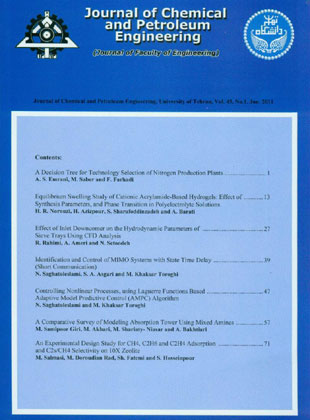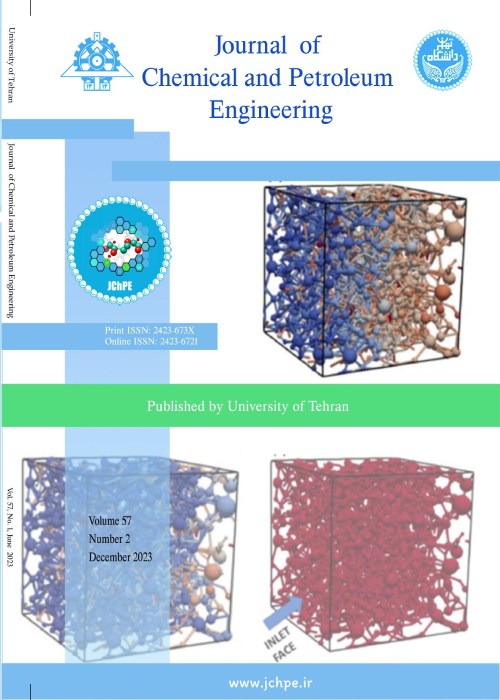فهرست مطالب

Journal of Chemical and Petroleum Engineering
Volume:45 Issue: 1, Jun 2011
- تاریخ انتشار: 1390/10/04
- تعداد عناوین: 7
-
-
Page 1Nitrogen is produced mainly from its most abundant source, the air, using three processes: membrane, pressure swing adsorption (PSA) and cryogenic. The most common method for evaluating a process is using the selection diagrams based on feasibility studies. Since the selection diagrams are presented by different companies, they are biased, and provide unsimilar and even controversial results. In order to provide an impartial evaluation means and getting an integrated and reliable selection method, all existing diagrams have been reviewed in this paper and integrated into a single diagram. With the help of proposed selection diagram and considering the operating conditions, flow rate and purity of Nitrogen, the most economic technology for separation of Nitrogen from the air can be chosen. Of course for some values of purity and flow rate, more than one technology can be selected. In these ranges, other parameters such as economic value of by-products phase of delivered product fluid (liquid or gaseous) and the product applications should be taken into account. In order to provide an engineering tool for selecting the most economic technology of Nitrogen production, a decision tree is proposed. With this decision tree one can choose the most suitable technology for its production. Heuristic rules along with literature data are implemented within the decision tree and it has been validated and updated with domestic Nitrogen producing companies. Generally for high capacity of Nitrogen production, the cryogenic process is the most economical alternative and for medium and low capacities, PSA and membrane systems are the best choices, respectively. Finally, a computer program is proposed to find out the most suitable technology for Nitrogen production.
-
Page 13Cationic copolymer gels of acrylamide and [(methacrylamido) Propyl] trimethyl ammonium chloride (MAPTAC) were synthesized by free radical aqueous solution polymerization. The Taguchi method, a robust experimental design, was employed for the optimization of the synthesis based on the equilibrium swelling capacity of the hydrogels. Based on Taguchi method a standard L16 orthogonal array with five factors at four levels was designed and experiments were done in accordance with it. The effects of network composition such as cross-linker density, ionizable monomer and total monomer concentration together with the initiator concentration on the equilibrium swelling capacity of hydrogels in distilled water were studied. From the analysis of variance (ANOVA) of the test results, the most effective factor controlling equilibrium swelling capacity was obtained and maximum water absorbency of the optimized hydrogel was found to be 3570 g/g. The presence of counterions in the external solution suppressed swelling of optimized hydrogel and this effect was pronounced with bivalent counterions. By using the thermodynamic model, the experimental data were analyzed and the cross-linking efficiency for the polymerization reaction was calculated to be about 40%.
-
Page 27Nowadays distillation is recognized as one of the economical and the most trustable separation methods in chemical, petroleum, gas and petrochemical industries. It is almost used as a first and the most applicable choice in separation methods. In this article the effect of inlet downcomer on the hydrodynamics of industrial sieve tray has been elaborated. The study was carried out by using a 3-D Computational Fluid Dynamics (CFD) method and was confirmed with experimental data. Commercial Ansys CFX 11 package software was used for the CFD analysis. Liquid velocity distribution on the tray was in better agreement with experimental data in comparison with simulation results without including inlet downcomer effect. Hydrodynamic parameters of clear liquid height, froth height and average liquid volume fraction in froth were predicted and compared with two available correlations. It was concluded that for having a better simulation model and hence having a deeper insight into tray performance, the downcomer effect on the mass transfer and hydraulic should be considered with CFD analysis.
-
Page 39Time-delay identification is one of the most important parameters in designing controllers. In the cases where the number of inputs and outputs in a system are more than one, this identification is of great concern. In this paper, a novel autocorrelation-based scheme for the state variable time-delay identification for multi-input multi-output (MIMO) system has been presented. This method is based on the stochastic phenomena which are capable of identifying each state variable independent of other variables, a control strategy for controlling such systems; and furthermore confirming the stability criteria. The results demonstrate the effectiveness of the proposed control strategy which has the advantage of confirming the stability, simple implementation and analysis.
-
Page 47Laguerre function has many advantages such as good approximation capability for different systems, low computational complexity and the facility of on-line parameter identification. Therefore, it is widely adopted for complex industrial process control. In this work, Laguerre function based adaptive model predictive control algorithm (AMPC) was implemented to control continuous stirred tank reactor (CSTR) process temperature runaways. Simulation result reveals that AMPC has a good performance in set-point tracking and load rejection. For comparison, a nonlinear model predictive control based on Laguerre- wiener model was also applied to the process. Simulation result demonstrates that the two controllers have the same performance in set point tracking and load rejection problem.
-
Page 57In natural gas treatment, the removal of CO2 and H2S in acid gases is a critical concern. There are various purification technologies that can be used for the removal of acid gas impurities. Absorption of acid gas into amines is one preferred method in gas industries. In the past, single amines was used, but recently in order to improve absorption performance, mixed amines with different solubility and reaction rates have been used. In this study, artificial neural network ANN is used as a method to model the absorption tower when uses mixed amines. A specified model which is simple in calculation and good in accuracy was developed. In this model back propagation learning is used and the corresponding parameters have been optimized. Finally, the new method has been compared with conventional mass transfer and equilibrium methods. The obtained results confirmed the simplicity and accuracy of the developed method.
-
Page 71CH4, C2H6 and C2H4 are the most important outlet gaseous of oxidative couple methane (OCM) reaction and this process is a new technology for conversion of natural gas to ethane and ethylene products. In this study, adsorption of OCM outlet hydrocarbons over 10X zeolite has been examined at equilibrium conditions. Temperature and pressure are the most effective operational parameters in the batch adsorption process. The central composite design was used for evaluating the effect of the operational conditions and optimization of adsorption process. The effect of temperature, pressure, their binary interaction and quadratic effects on adsorption capacity and selectivity of C2s/CH4 over 10X zeolite was determined to realize the optimal condition for enhancement of ethane and ethylene separation from methane. Optimization of the effective parameters was carried out by the statistical approach and the maximum predicted value of C2's selectivity over CH4 was calculated 15.6, using the quadratic model at temperature of 308.15 K and atmospheric pressure. Finally, dynamic adsorption was carried out for the mixed gases at optimal conditions. Significant difference was observed between the breakthrough times of methane, ethane, and ethylene. It is concluded that 10X zeolite would be an efficient adsorbent for the separation of methane from the ethane and ethylene.


